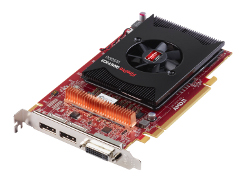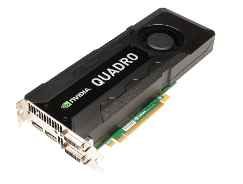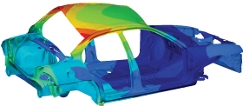AMD and Nvidia have yet again raised the stakes in professional 3D graphics. AMD’s new FirePro W Series features four new GPUs for mid-range and high-end 3D workflows.

To view a PDF of this article, and see a chart comparing the specifications and benchmark results for these graphics cards, click here
Meanwhile, Nvidia has given a hint of what to expect from its Kepler architecture with the launch of the high-end Quadro K5000.
AMD FirePro W Series
AMD has gone ‘all in’ for its new generation ‘Southern Islands’ 28nm GPUs, with four new cards based on its Graphics Core Next (GCN) architecture: the FirePro W5000 (2GB), W7000 (4GB), W8000 (4GB) and W9000 (6GB).
We also expect AMD to release one or two lower-end cards in 2013, targeting entry-level CAD. In terms of price/performance, the FirePro W5000 and W7000, both single height cards, look to be at the sweet spot for most CAD users.

AMD FirePro W5000
The FirePro W7000 stands out for its 4GB of GDDR5 memory, more than enough for most CAD workflows and double that of its predecessor, the FirePro V7900.
The FirePro W8000 and W9000 take up two PCI Express slots on the motherboard and are more suited to high-end workflows, particularly where users are looking to use the additional performance on offer for GPU compute (see box out).
In addition to performance for graphics and compute, AMD’s new W Series cards can be differentiated by the number of display outputs on offer. The W5000 has three for extended desktop support through AMD Eyefinity.
The W7000 and W8000 have four and the W9000 six, which also makes these cards suitable for powerwalls with multiple HD displays arranged in a 2 x 2 or 3 x 2 array.
Moving beyond six displays, all but the FirePro W5000 can be used to drive even higher-resolution powerwalls. Here the optional S400 Synchronisation Module is used to sync cards in multiple workstations.
Stereo support is standard on the FirePro W8000 and W9000. For a more in-depth look at the AMD FirePro W Series click here
NVIDIA Quadro K5000
Nvidia has kicked off its Kepler-based professional GPU family with a single highend card – the Quadro K5000.
We expect it will be joined in 2013 with lower cost boards offering price / performance more suited to mainstream CAD, as well as a high-end GPU to replace the Fermi-based Quadro 6000.

Nvidia Quadro K5000
The Quadro K5000 is a double height card and features 4GB GDDR5 memory, more than enough for most CAD-centric workflows. Four display outputs and a new display engine make it possible to support up to four HD displays, a feature that was previously exclusive to high-end AMD FirePro cards.
As with AMD, it’s also possible to step things up and use four Quadro K5000s together with Nvidia Quadro Mosaic technology for an ultra high-resolution 3D powerwall. Here, up to 16 displays can be driven from a single workstation or from multiple machines using the optional Quadro Sync card.
Power efficiency is a big focus for the Quadro K5000 with Nvidia claiming Kepler is three times more energy efficient than its predecessor, Fermi.
This is highlighted in the Quadro K5000’s max power consumption rating of 122W, lower than its predecessor, the Quadro 5000, as well as AMD’s new FirePro W8000, which is pitched around the same level in terms of features and performance.
Performance
We tested all the new cards with three real world applications: PTC Creo 2.0 and SolidWorks 2013 for CAD, as well as 3ds Max 2011, which is used for design visualisation.
Our test machine, a Workstation Specialists WSX 6 V2, features an overclocked Core i7 3930K CPU, 32GB of RAM and an Intel 520 Series SSD.
For Creo we use the SPECapc benchmark (spec.org), which tests for wireframe, shaded and aggregates the two (composite).
For SolidWorks we test with two different models — an engineering model with shading and edges, and a camera model with RealView, the real time rendering mode.
For 3ds Max we use the SPECapc benchmark, which features a wide variety of models to test for interactive graphics and GPU shaders.
First off, our tests show that the new AMD FirePro cards are big step up from the previous generation with the W5000 significantly outpacing the V5900 it replaces.
AMD FirePro V5900
Our results also confirm what we have maintained at DEVELOP3D for some years: a high-end card is overkill for most CAD-based workflows, with both the FirePro W5000 and W7000 offering excellent price/performance.
In the past there have been caveats to this, such as the amount of on-board memory, but with all the new cards now starting at 2GB, this is no longer an issue for all but the most high-end of CAD workflows.
The fact is that 3D performance in many CAD applications is still limited by the GHz of the CPU, which means high-end cards like the Quadro K5000 and FirePro W8000 are not able to fulfil their true potential.
There are glimpses of what more power can offer when a heavier load is placed on the GPU. The shaded (Creo), RealView (SolidWorks) and GPU shaders (3ds Max) tests all show a significant jump when moving from the FirePro W5000 to the W7000.
Beyond the benchmarks, there are other benefits to be had. Creo 2.0 users, for example, may be interested to learn of a new GPU-accelerated mode called Order Independent Transparency (OIT), which can significantly boost performance when using transparency.
This feature is currently specific to AMD FirePro graphics cards, however. For Nvidia, the Quadro K5000 gives a glimpse of what Kepler can achieve with excellent scores in all of our tests. At £1,459, however, the card is too high-end for most CAD users.
All eyes are now on Nvidia to see how it scales things down in 2013 for the volume CAD market. Its new cards will need to deliver a compelling balance of price/performance
and features, to take the fight to AMD and its impressive FirePro W5000 and W7000.
GPU compute
A GPU isn’t necessarily just for 3D graphics.
It can also be used to solve complex calculations, such as those used in simulation (CAE) and ray trace rendering. This is called GPU compute and should probably be given some consideration before investing in your next GPU.
First of all, it’s important to understand that AMD and Nvidia differ in their approaches to GPU compute. AMD FirePro GPUs are designed for both graphics (OpenGL / DirectX) and GPU compute (OpenCL).
The high-end FirePro W8000 and W9000 are the most suited to GPU compute, boasting good double precision performance, which is important for simulation. So while the FirePro W5000 or W7000 should satisfy most 3D CAD requirements for graphics, GPU compute workflows will benefit from investment in a higher end card.
AMD relies on OpenCL for GPU compute, but the number of applications that support the open standard for parallel programming are still quite thin on the ground. This should change in 2013.
Nvidia takes a different approach. It recommends using two GPUs: a Quadro GPU for 3D graphics (OpenGL and DirectX) and a Tesla GPU for GPU compute (CUDA and OpenCL). This is tied together with Nvidia Maximus.
Maximus has the advantage of being able to dedicate individual GPUs to both graphics and GPU compute. However, this means the overall system cost is higher.
As Maximus supports Nvidia CUDA as well as OpenCL there are a lot more options when it comes to simulation and rendering applications.
For more info see DEVELOP3D’s GPU compute guide.







